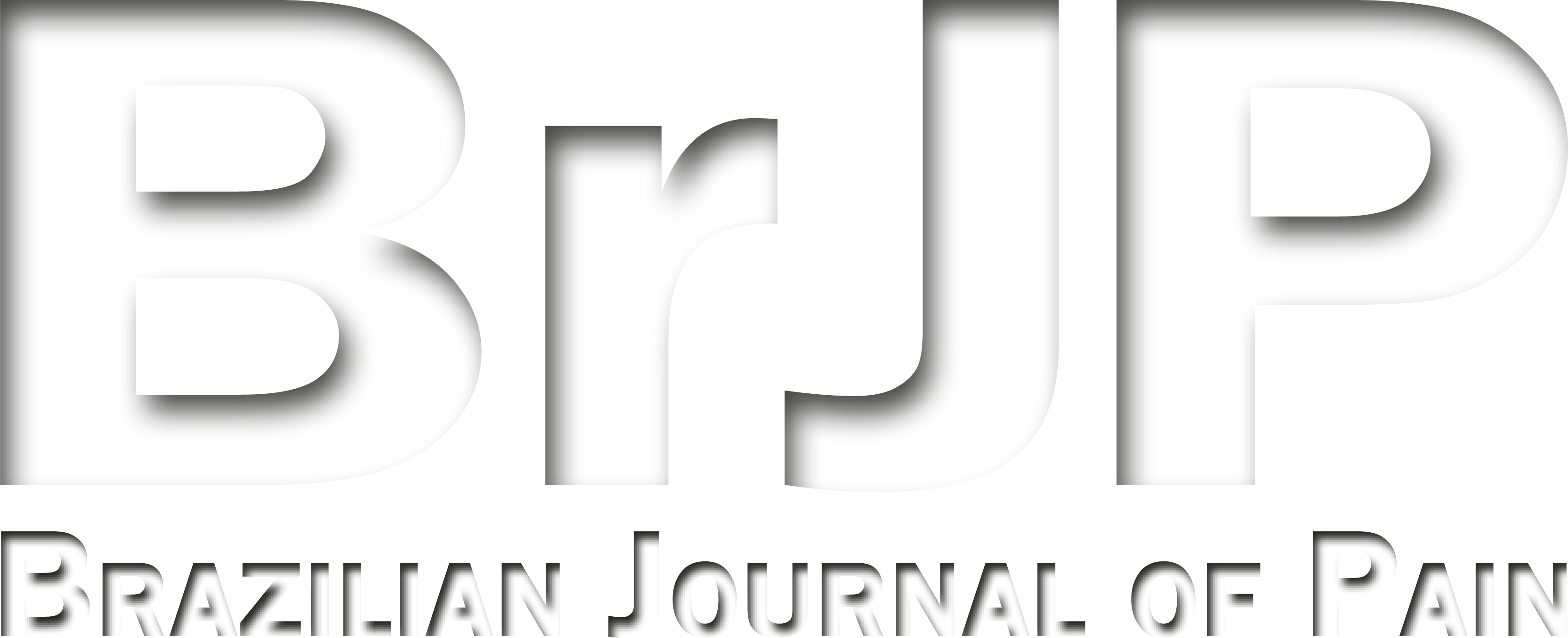Subtypes of temporomandibular disorders in patients diagnosed with otalgia: observational study
Subtipos de desordem temporomandibular em pacientes diagnosticados com otalgia: estudo observacional
Dilene Marques Henrique de Albuquerque; Luciane Lacerda Franco Rocha Rodrigues; Márcio Rogério Onofre Duarte; Carlos Augusto Fernandes; Expedito Nóbrega de Oliveira; António Sérgio Guimarães
Abstract
Keywords
Resumo
JUSTIFICATIVA E OBJETIVOS: A disfunção temporomandibular (DTM) possui sintomas complexos que envolvem a região orofacial, como a otalgia. Considerando os difíceis diagnósticos diferenciais para associar sintomas otológicos com DTM. O objetivo deste estudo foi verificar o diagnóstico de DTM em pacientes com otalgia.
MÉTODOS: Este é um estudo transversal e descritivo, com uma avaliação de 75 pacientes diagnosticados com otalgia. O questionário de triagem da Academia Europeia de Disfunções Craniomandibulares (EACD) foi aplicado inicialmente, e aqueles que responderam afirmativamente a pelo menos uma questão foram avaliados pelo Critério Diagnóstico de Pesquisa para Disfunções Temporomandibulares (DC/TMD), com amostra final de 50 pacientes. Os dados foram tabulados e por meio da ANOVA foi verificado se havia diferença estatística entre os subtipos de DTM classificados pelo DC/TMD, considerando intervalos de confiança com 95% de significância.
RESULTADOS: A idade média dos participantes foi de 39,9±14,1 anos. Além disso, predominou-se o sexo feminino (76%) (p<0,0001), com maior percentual em todos os subtipos avaliados, destacando-se a artralgia (82%) e a dor miofascial com limitação de abertura (81,8%), seguida da dor miofascial (74%) e deslocamento de disco com redução (72,7%). Quando observada a distribuição dos subtipos de DTM entre os sexos, notou-se predominância de dor miofascial no sexo masculino (75%) e feminino (68%), mas não foi observada significância estatística nessa variável e nas demais estudadas.
CONCLUSÃO: Os pacientes com otalgia manifestaram mais de um dos subtipos de DTM, sendo o subtipo de dor miofascial o mais prevalente entre os participantes do estudo.
Palavras-chave
References
1 Omolehinwa TT, Mupparapu M, Akintoye SO. Incidental finding of an extensive oropharyngeal mass in magnetic resonance imaging of a patient with temporomandibular disorder: A case report. Imaging Sci Dent. 2016;46(4):285-90.
2 Schiffman E, Ohrbach R, Truelove E, Look J, Anderson G, Goulet JP, List T, Svensson P, Gonzalez Y, Lobbezoo F, Michelotti A, Brooks SL, Ceusters W, Drangsholt M, Ettlin D, Gaul C, Goldberg LJ, Haythornthwaite JA, Hollender L, Jensen R, John MT, De Laat A, de Leeuw R, Maixner W, van der Meulen M, Murray GM, Nixdorf DR, Palla S, Petersson A, Pionchon P, Smith B, Visscher CM, Zakrzewska J, Dworkin SF; International RDC/TMD Consortium Network, International association for Dental Research; Orofacial Pain Special Interest Group, International Association for the Study of Pain. Diagnostic Criteria for Temporomandibular Disorders (DC/TMD) for Clinical and Research Applications: recommendations of the International RDC/ TMD Consortium Network* and Orofacial Pain Special Interest Group†. J Oral Facial Pain Headache. 2014;28(1):6-27.
3 Gauer RL, Semidey MJ. Diagnosis and treatment of temporomandibular disorders. Am Fam Physician. 2015;91(6):378-86.
4 Natu VP, Yap AU, Su MH, Irfan Ali NM, Ansari A. Temporomandibular disorder symptoms and their association with quality of life, emotional states, and sleep quality in South-East Asian youths. J Oral Rehabil. 2018;45(10):756-63.
5 Renton T. Chronic pain and overview and differential diagnoses of non-odontogenic orofacial pain. Prim Dent J. 2019;7(4):71-86.
6 Silva FF, Barroso MSF, Guimarães AS, Valadas LAR, Rodrigues LLFR. Relationship between myofascial pain and facial types: an observational study. Braz Dental Sci. 2023;26(1):e3725.
7 Bonato LL, Quinelato V, De Felipe Cordeiro PC, De Sousa EB, Tesch R, Casado PL. Association between temporomandibular disorders and pain in other regions of the body. J Oral Rehabil. 2017;44(1):9-15.
8 Costa YM, Conti PC, de Faria FA, Bonjardim LR. Temporomandibular disorders and painful comorbidities: clinical association and underlying mechanisms. Oral Surg Oral Med Oral Pathol Oral Radiol. 2017;123(3):288-97.
9 Jang JY, Kwon JS, Lee DH, Bae JH, Kim ST. Clinical signs and subjective symptoms of temporomandibular disorders in instrumentalists. Yonsei Med J. 2016;57(6):1500-7.
10 Fehrenbach J, da Silva BSG, Brondani LP. A associação da disfunção temporomandibular à dor orofacial e cefaleia. J Oral Investig. 2018;7(2):69-78.
11 Beaumont S, Garg K, Gokhale U, Heaphy N. Temporomandibular disorder: a practical guide for dentists in diagnosis and treatment. Aust Dent J. 2020;65(3):172-80.
12 Baart JA, Bosgra JF. Dentogene pijnklachten [Odontogenic pain]. Ned Tijdschr Tandheelkd. 2016;123(10):484-90.
13 Koh SWC, Li CF , Loh PSJ, Wong ML. Managing tooth pain in general practice. Singapura Med J. 2019;60(5):224-8.
14 De Felício CM, Melchior Mde O, Ferreira CL, Da Silva MA. Otologic symptoms of temporomandibular disorder and effect of orofacial myofunctional therapy. Cranio. 2008;26(2):118-25.
15 Berguer A, Kovacs F, Abraira V, Mufraggi N, Royuela A, Muriel A, Gestoso M, Falahat F, Martín-Granizo R, Zamora J. Neuro-reflexotherapy for the management of myofascial temporomandibular joint pain: a double-blind, placebo-controlled, randomized clinical trial. J Oral Maxillofac Surg. 2008;66(8):1664-77.
16 Stepan L, Shaw CL, Oue S. Temporomandibular disorder in otolaryngology: systematic review. J Laryngol Otol. 2017;131(S1):S50-6.
17 Israel HA, Davila LJ. The essential role of the otolaryngologist in the diagnosis and management of temporomandibular joint and chronic oral, head, and facial pain disorders. Otolaryngol Clin North Am. 2014;47(2):301-31.
18 Peric A. Nasal septal spur associated with rhinogenic contact point otalgia and tinnitus. Craniomaxillofac Trauma Reconstr. 2019;12(1):67-9.
19 Silveira AM, Feltrin PP, Zanetti RV, Mautoni MC. Prevalence of patients harboring temporomandibular disorders in an otorhinolaryngology department. Braz J Otorhinolaryngol. 2007;73(4):528-32.
20 Maciejewska-Szaniec Z, Maciejewska B, Mehr K, Piotrowski P, Michalak M, Wiskirska-Woźnica B, Klatkiewicz T, Czajka-Jakubowska A. Incidence of otologic symptoms and evaluation of the organ of hearing in patients with temporomandibular disorders (TDM). Med Sci Monit. 2017;23:5123-9.
21 Honorato MCM, Tavares LF, Bedaque HP, Mantello EB, Almeida EO, Ribeiro KMOBF, Ferreira LMBM. Otoneurological assessment and quality of life of individuals with complaints of dizziness and temporomandibular disorders: a case-control study. Braz J Otorhinolaryngol. 2022;88 Suppl 3(Suppl 3):S185-S191.
22 Cooper BC, Cooper DL. Recognizing otolaryngologic symptoms in patients with temporomandibular disorders. Cranio. 1993;11(4):260-7.
23 Szarejko KD, Gołębiewska M, Lukomska-Szymanska M, Kuć J. Stress experience, depression and neck disability in patients with temporomandibular disorder-myofascial pain with referral. J Clin Med. 2023;12(5):1988.
Submitted date:
05/16/2023
Accepted date:
11/30/2023


